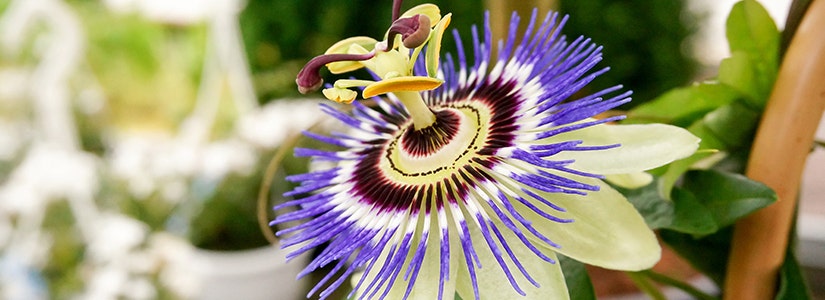

- Home
- Solution Center
- Learn
- Rose & Flower
- Growing Vines: Fall Beauty
Growing Vines: Fall Beauty
Vines are nature's exclamation points. Stretching skyward, they punctuate a planting with vertical interest. As these gravity-defying plants scale supports, they lift color to eye level and beyond.
Perennial vines introduce come-back color to a landscape, returning reliably year after year. You can add climbers to your yard that boast color in any season. For fall finery, try a few of these vines.

Blue Passionflower (Passiflora caerulea)
Large, 3-4-inch-wide purple and white blooms add exotic, architectural interest to the garden. Leaves are attractive, opening to reveal five lobes. Blossoms appear sporadically through summer; heaviest flowering occurs from late summer through early fall. Plants host Gulf Fritillary Caterpillars, which rapidly gobble leaves.
- Hardiness: USDA Zones 6-11
- Size: 40-plus feet tall and 6-8 feet wide; in cold regions, plants typically grow up to 10 feet in a single growing season
- How Vines Climb: By tendrils and twining stems

Sweet Autumn Clematis (Clematis terniflora)
Sweetly fragrant white blossoms open from late summer through fall. Vines grow rampantly and can be used as a dense ground cover. Flowers form on new growth. Prune hard after flowering or in early spring, cutting back to one to two buds.
- Hardiness: USDA Zones 5-10
- Size: 15-30 feet tall and wide
- How Vines Climb: By tendrils and twining stems

Harlequin Common Honeysuckle (Lonicera periclymenum 'Harlequin')
In the growing season, leaves sport several shades of green with white edges. In autumn, leaves shift to bright pink. Pink and cream blossoms appear in spring. This Honeysuckle isn't invasive; you can even prune it to form a tidy shrub. Prune immediately after flowering.
- Hardiness: USDA Zones 3-10
- Size: 8-10 feet tall and 5-6 feet wide
- How Vines Climb: By twining stems; may need to be tied to supports as it grows

Purple-Leaf Grape (Vitis vinifera 'Purpurea')
Grapevines grace autumn scenes with colorful foliage – no matter the type. But you'll relish the fiery red hues that appear on Purple-Leaf Grape in fall. During the growing season, this drought-tolerant, noninvasive vine has deep-purple leaves. Some say fruit is inedible; others like it for juice and jelly. In shade, leaves remain green.
- Hardiness: USDA Zones 5-10
- Size: 8-30 feet tall and 2-3 feet wide

Boston Ivy (Parthenocissus tricuspidata)
Glossy green leaves are three-lobed, or divided and turn a brilliant crimson or purple in autumn. These tough vines tolerate full shade and many soil conditions, including drought. This is the ivy in Boston's Fenway Park. Choose this vine's location with care. Tendrils have adhesive disks on the ends that can ruin surfaces when removed, including painted wood, mortar and stucco.
- Hardiness: USDA Zones 3-11
- Size: 30-70 feet tall and 5-10 feet wide
- How Vines Climb: By tendrils

Golden Hops (Humulus lupulus 'Aureus')
Leaves emerge bright chartreuse in early spring and mature to medium green in summer. Flowers appear in summer in hanging bracts that ripen in late summer and autumn to form hops, which are attractive hanging among foliage. In cold zones, plants die to the ground in winter; prune stems to the ground after a hard frost. In warmer zones, prune to the ground in winter. In some regions, hops attract Aphids, followed by hordes of Ants and Wasps. Check with your local Cooperative Extension System office before planting to avoid possible pest issues.
- Hardiness: USDA Zones 4-11
- Size: 15-25 feet tall and 4-6 feet wide
- How Vines Climb: By twining stems
Other things to consider for success:
Planting – In all regions, plant vines in fall, as long as they're available for sale at local nurseries. In coldest zones, stop planting six weeks before the average last frost date. In warmer zones, continue planting as long as soil isn't frozen.
Support – What type of support your vine will require depends on how it climbs and its growth rate. Make sure any support is well-anchored in soil. A vine-covered support is top-heavy; high winds can wrestle it to the ground.
Pruning – Most vines require some type of annual pruning, and some grow rapidly enough that you'll need to keep growth in check with monthly trimming. With flowering vines, you need to time pruning to avoid reducing flower numbers. Check with your local nursery or local Cooperative Extension System office to learn when to prune your vines.
Tie And Guide – As vines grow, monitor stems and direct them where you want them to go. If vines don't cling or wrap around supports, tie stems in weekly.
Size – Size varies by region. In warmer zones, vines have longer growing seasons and can grow taller and wider than in cold regions, where fall frosts and hard winters curtail growth. Check with your local nursery or local Cooperative Extension System office to obtain size data for your locale.
Invasive Vines – Some vines are invasive in some regions. Check with your local native plant society or state Department of Natural Resources before planting. Or visit invasiveplantatlas.org.














